Why participation in Forest Planning is so important
Perhaps now more than ever our public lands are an important public space for all of us to enjoy and recreate upon. They are our sanctuary, a place of peace and, dare we say it, isolation from the cares and worries of our modern life. This is why we have to be so vigilant in ensuring these lands aren’t closed off to us.
AMPL is beginning the process of taking public comments on one forest in particular, the Bridger Teton National Forest (BTNF), which will soon be placed into the U.S. Forest Service’s formal “Forest Planning” process.
What is Forest Planning? It’s a federally required process done every 15 years or so to each of our national forests. The Plan itself is not focused on specific projects or specific trails, but rather, it focuses on the “bigger picture” of the entire forest’s land management and uses. In particular, this planning identifies “management areas and geographic areas designated as places where particular activities or goals can be considered (for example areas suitable for timber harvest, motorized recreation, grazing, and wilderness designation).” (USDA, A Citizen’s Guide to Forest Planning)
Why is participation in Forest Planning so important? Because without those of us who recreate being part of the discussion, special interest groups that want to see our forest systems turned into more and more wilderness will push to do just that. We have to make sure we are heard.
Think we need more wilderness?
Take a look at these figures from the USDA’s most recent BTNF monitoring report:
That’s right, over 33% of the forest is already primitive wilderness, meaning it is not open for motorized or mechanized recreation. And another 34%, adding up to 67% in total, is closed to motorized.
In the same report, the USDA states the BTNF has an above national average amount of non-motorized trails within the forest system. “Compared to the national average (62%), the portion of non-motorized trails on BTNF is high (91%). This is a result of the relatively high portion of BTNF that are wilderness….” (USDA, Biennial Monitoring Evaluation Report, BTNF, page 61)
Want to see that in acres?
These numbers explain why the Forest Planning process is so important to those of us who wish to keep our recreational opportunities open. And the good news is, this next round of forest planning on the BTNF will happen under new rules (2012 Planning Rules) which call for “enhanced public involvement,” meaning the Forest Service must allow for, and indeed look for, ways to engage the public in the planning process.
AMPL intends to bring more comments from all our recreationists to the table, which is why we have digitized our public comment form on our website, making it easier than ever for our followers to comment on where and how they access the BTNF and what kinds of recreation they enjoy there.
We also have a section on the form asking for support in removing the wilderness study area designation from the Palisades and Shoal Creek Wilderness Study Areas, an important step in ensuring these areas are not turned into wilderness and locked away from us forever.
As a community of recreationists, we can be sure our voices are heard. So, head over to our webpage – and click on the Public Comments Button at the top of the page. Fill out the form and we’ll add your comments to the stack we intend to present to the Forest Service during Forest Planning.




